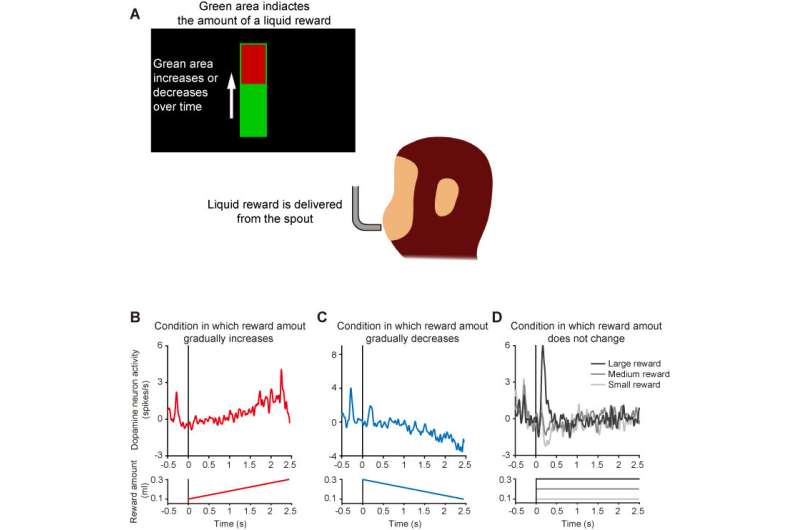The shape of things to come: Shifting rewards are encoded using special neuronal patterns


Animals must make predictions about future rewards when making decisions during daily life. Specific reward-related patterns of neuronal activity are known to underlie such decisions. But now, researchers from Japan have found a new pattern of neural activity that occurs when responding to rewards that are changing over time.
In a study published this month in eLife, researchers from the University of Tsukuba have revealed that dopamine neurons, which process information about rewards, are activated in a previously undetected way when an animal considers a reward that is changing in value.
Previous studies have highlighted the importance of a specific pattern of activity in dopamine neurons, called phasic firing, in processing reward information. Such information has important implications for understanding how organisms successfully regulate reward-seeking behavior. However, this type of activity may not explain all types of rewards—for instance, those that change on a moment-to-moment basis, such as when a customer watches as a bartender pours their drink. The researchers at the University of Tsukuba aimed to investigate this possibility.
“Midbrain dopamine neurons are thought to respond to rewards and reward-predicting cues with phasic activity,” says first author of the study Yawei Wang. “However, it seems unlikely that phasic dopamine activity, which is sporadic and has a short duration, can explain continuous monitoring of a shifting reward.”
To address this, the researchers trained macaque monkeys to complete a Pavlovian task in which they made judgments about rewards that gradually increased or decreased. While the monkeys completed the task, the researchers recorded the activity in dopamine neurons that process information about the rewards.
“The results were surprising,” explains Professor Masayuki Matsumoto, senior author. “Instead of phasic activity, the dopamine neurons fired in a tonic pattern that varied according to the moment-to-moment changes in the reward values.”
This tonic firing pattern, which was a more sustained neuronal response compared with phasic firing, was caused by a different type of neuronal activation than that associated with phasic dopamine neuron activity during reward processing.
“Our findings add to the current understanding of how dopamine neurons are involved in rewards by highlighting the existence of multiple neuronal firing modes that signal reward values in specific situations,” says Yawei Wang.
Source: Read Full Article